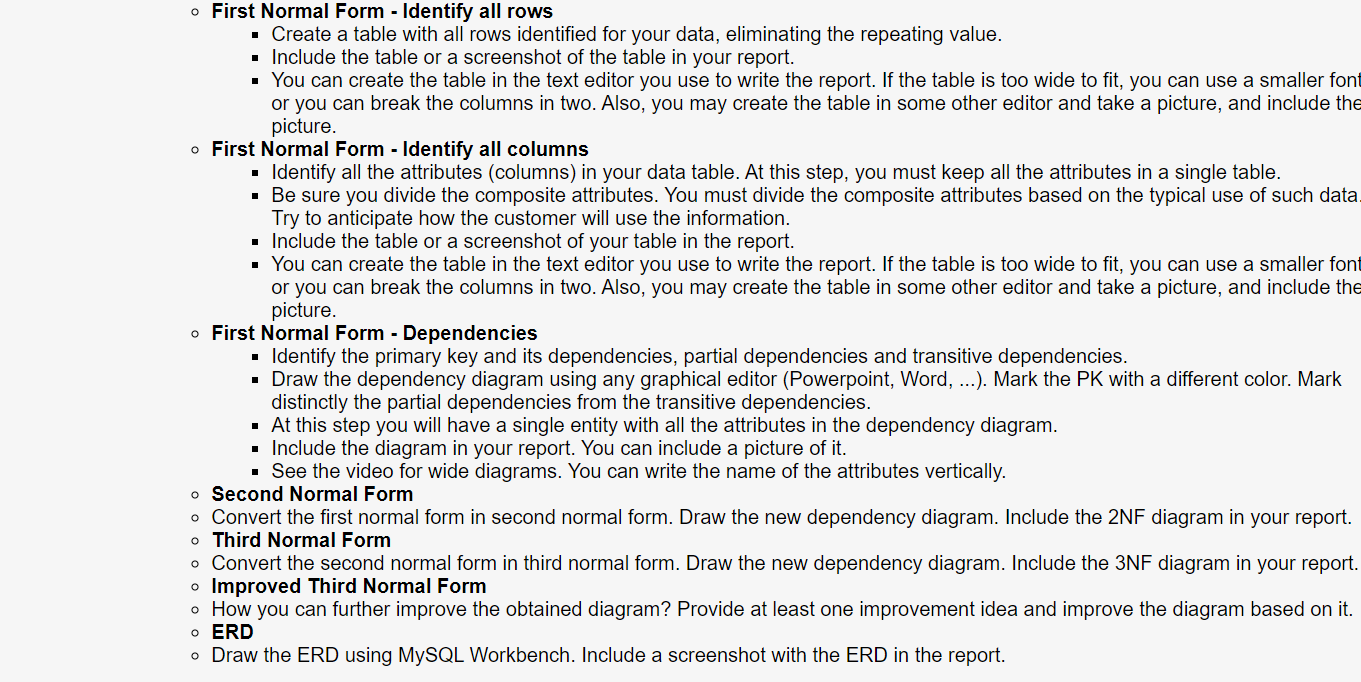

- First Normal Form - Identify all rows - Create a table with all rows identified for your data, eliminating the repeating value. - Include the table or a screenshot of the table in your report. - You can create the table in the text editor you use to write the report. If the table is too wide to fit, you can use a smaller fon or you can break the columns in two. Also, you may create the table in some other editor and take a picture, and include the picture. - First Normal Form - Identify all columns - Identify all the attributes (columns) in your data table. At this step, you must keep all the attributes in a single table. - Be sure you divide the composite attributes. You must divide the composite attributes based on the typical use of such data Try to anticipate how the customer will use the information. - Include the table or a screenshot of your table in the report. - You can create the table in the text editor you use to write the report. If the table is too wide to fit, you can use a smaller fon or you can break the columns in two. Also, you may create the table in some other editor and take a picture, and include the picture. - First Normal Form - Dependencies - Identify the primary key and its dependencies, partial dependencies and transitive dependencies. - Draw the dependency diagram using any graphical editor (Powerpoint, Word, ...). Mark the PK with a different color. Mark distinctly the partial dependencies from the transitive dependencies. - At this step you will have a single entity with all the attributes in the dependency diagram. - Include the diagram in your report. You can include a picture of it. - See the video for wide diagrams. You can write the name of the attributes vertically. - Second Normal Form - Convert the first normal form in second normal form. Draw the new dependency diagram. Include the 2NF diagram in your report. - Third Normal Form - Convert the second normal form in third normal form. Draw the new dependency diagram. Include the 3NF diagram in your report. - Improved Third Normal Form - How you can further improve the obtained diagram? Provide at least one improvement idea and improve the diagram based on it. - ERD - Draw the ERD using MySQL Workbench. Include a screenshot with the ERD in the report. For this fictional scenario you must apply the instructions linked above. A hospital chain wants to model their appointment system. Their current appointments are kept in a spreadsheet system. All the hospitals are in similar buildings and having the same internal organization. A relevant historical fragment is provided below: In addition the following business rules were identified: - A doctor works in one or more hospitals. A hospital has many doctors. - A doctor uses the same suite for all the appointments. A suite is used by several doctors. - A doctor has many patient appointments. An appointment is for a given doctor. - A patient has many doctor appointments. An appointment is for a given patient. - The first names and last names are having at most 25 characters each. Middle names are not stored








